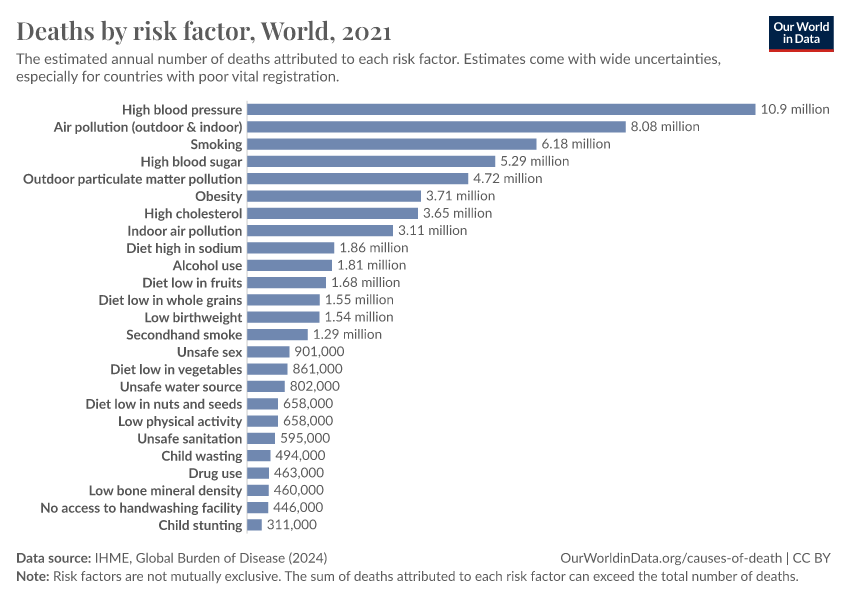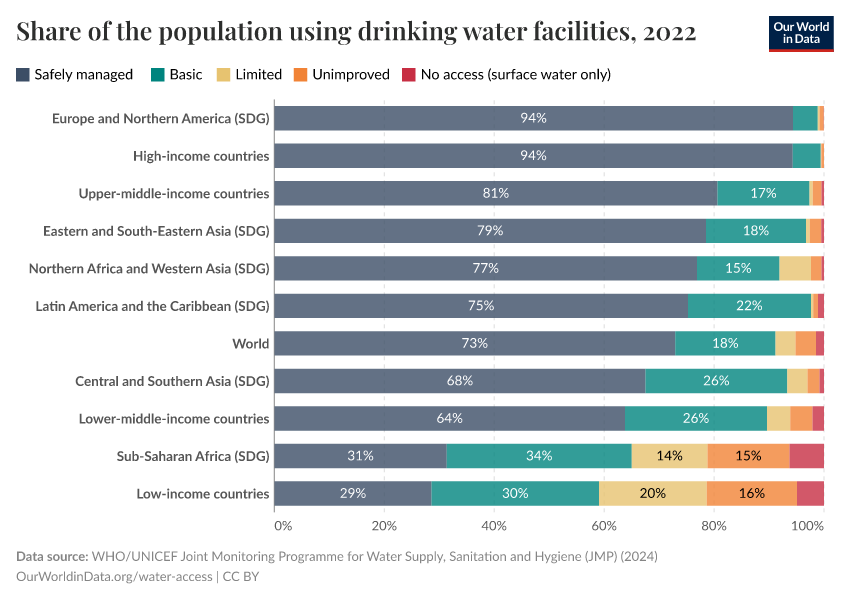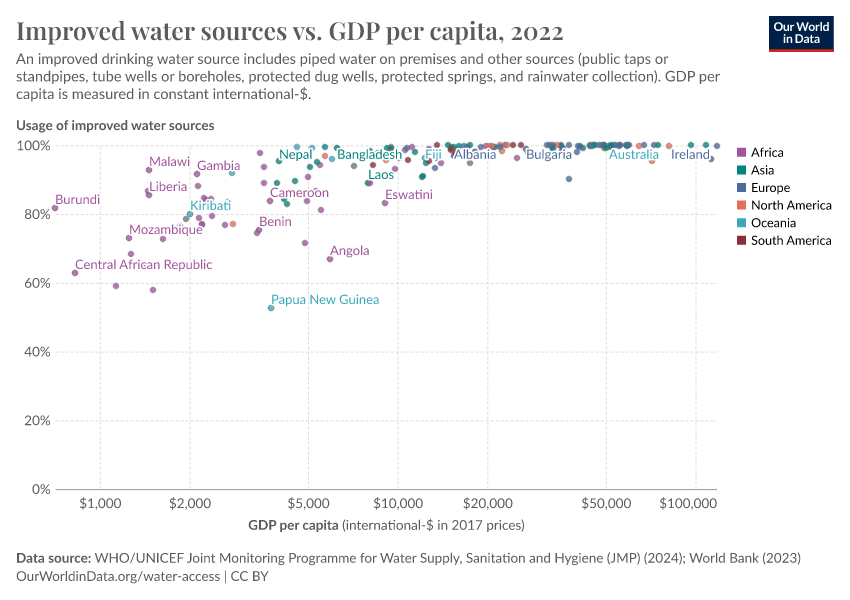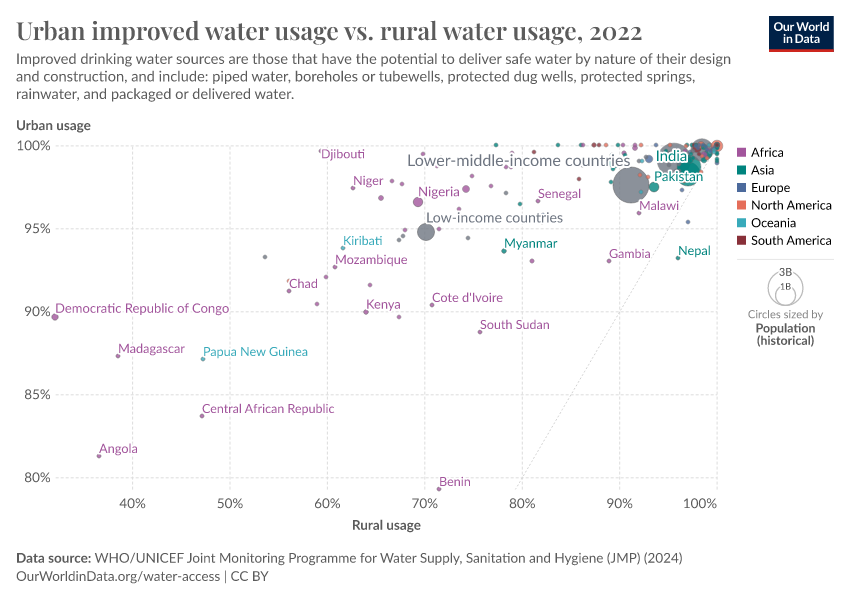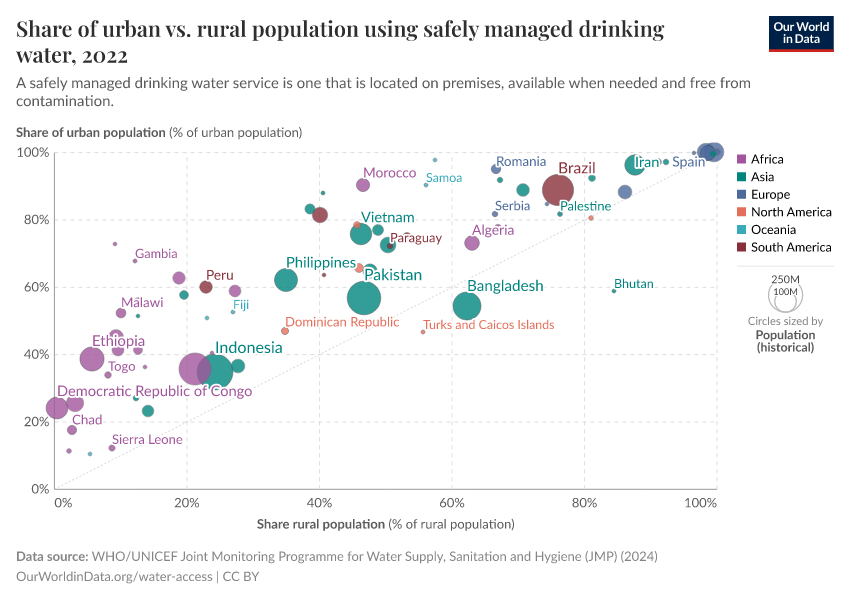Clean Water
Clean and safe water is essential for good health. How did access change over time? Where do people lack access?
Access to clean water is one of our most basic human needs.
However, one in four people in the world does not have access to safe drinking water, which is a major health risk. Unsafe water is responsible for more than a million deaths each year.
This article looks at data on access to safe water and its implications for health worldwide.
Unsafe water sources are responsible for over one million deaths each year
Unsafe water is one of the world's largest health and environmental problems, particularly for the poorest people.
The Global Burden of Disease is a major global study on the causes and risk factors for death and disease published in the medical journal The Lancet. These estimates of the annual number of deaths attributed to a wide range of risk factors are shown here.
Lack of access to safe water sources is a leading risk factor for infectious diseases, including cholera, diarrhea, dysentery, hepatitis A, typhoid, and polio.1 It also exacerbates malnutrition and, in particular, childhood stunting. The chart shows that it ranks globally as a significant risk factor for death.
The global distribution of deaths from unsafe water
In low-income countries, unsafe water sources account for a significant share of deaths
Globally, unsafe water sources account for a few percent of deaths.
In low-income countries, it accounts for around twice as many deaths.
The map here shows the share of annual deaths attributed to unsafe water worldwide.
When we compare the share of deaths attributed to unsafe water over time or between countries, we are not only comparing the extent of water access but its severity in the context of other risk factors for death. Clean water's share depends not only on how many die prematurely from it but also on what else people are dying from and how this is changing.
Death rates are much higher in low-income countries
Death rates from unsafe water sources give us an accurate comparison of differences in mortality impacts between countries and over time. In contrast to the share of deaths that we studied before, death rates are not influenced by how other causes or risk factors for death are changing.
This map shows the death rates from unsafe water sources worldwide. Death rates measure the number of deaths per 100,000 people in a given country or region.
What becomes clear is the significant differences in death rates between countries: rates are high in lower-income countries, particularly across Sub-Saharan Africa and Asia. Rates here are often greater than 50 deaths per 100,000 people.
Compare this with death rates across high-income countries: across Europe, rates are below 0.1 deaths per 100,000. That’s a greater than 1000-fold difference.
Therefore, unsafe water sources are limited primarily to low and lower-middle-income countries.
This relationship is clearly shown when we plot death rates versus income, as shown here. There is a strong negative relationship: death rates decline as countries get richer.
Access to safe drinking water
What share of people have access to safe drinking water?
Sustainable Development Goal (SDG) Target 6.1 is to: “achieve universal and equitable access to safe and affordable drinking water for all” by 2030.
Almost three-quarters of the world's population uses a safely managed water source. One in four people does not use a safe drinking water source.
The following chart breaks down drinking water use globally and across regions and income groups. In countries with the lowest incomes, less than one-third of the population uses safely managed water. Most live in Sub-Saharan Africa.
The world has made progress in recent years, but unfortunately, this has been very slow. In 2015 (at the start of the SDGs), around 70% of the global population had safe drinking water, and this has slowly increased over recent years.
If progress continues at these slow rates, we will not reach the target of universal, equitable access to safe and affordable drinking water by 2030.
In the map shown, we see the share of people worldwide using safe drinking water facilities.
How many people do not have access to safe drinking water?
The map shows the number of people worldwide who do not use safe drinking water facilities.
What share of people do not use an improved water source?
The definition of an improved drinking water source is: “...those that have the potential to deliver safe water by nature of their design and construction, and include: piped water, boreholes or tubewells, protected dug wells, protected springs, rainwater, and packaged or delivered water.” Note that drinking water from an improved source does not ensure that the water is safe or adequate, as these characteristics are not tested at the time of the survey. However, improved drinking water technologies are more likely than unimproved ones to provide safe drinking water and prevent contact with human excreta.
The map shows the share of people worldwide who do not use improved water sources.
The map shows the number of people worldwide who do not use improved water sources.
What determines levels of clean water usage?
Usage of improved water sources increases with income
The visualization shows the relationship between improved water source usage and gross domestic product (GDP) per capita. We see a general link between income and improved water source usage.
Typically, most countries with more than 90% of households with improved water have an average GDP per capita of over $10,000 to 15,000. Those at lower incomes tend to have a larger share of the population without access.
Although income is an important determinant, the range of levels of usage that occur across countries of similar prosperity further supports the suggestion that other important governance and infrastructural factors contribute.
Rural households often lag in improved water usage
In addition to the significant inequalities in improved water usage between countries, there can also be large differences within countries. In the charts, we plotted the share of the urban versus rural population using improved water sources and safely managed drinking water, respectively. Here, we have also shown a line of parity; if a country lies along this line, then access in rural and urban areas is equal.
Since nearly all points lie above this line, with few exceptions, usage of improved water sources is greater in urban areas than rural ones. This may be partly attributed to an income effect; urbanization is a trend strongly related to economic growth.2
The infrastructural challenges of developing municipal water networks in rural areas are also likely to contribute to lower usage levels relative to urbanized populations.
Definitions
Improved water source: "Improved drinking water sources can deliver safe water by nature of their design and construction, and include: piped water, boreholes or tube wells, protected dug wells, protected springs, rainwater, and packaged or delivered water".
Using drinking water from an improved source does not ensure that the water is safe or adequate, as these characteristics are not tested at the time of the survey. However, improved drinking water technologies are more likely than those characterized as unimproved to provide safe drinking water and prevent contact with human excrement.
Safely managed drinking water: "Safely managed drinking water" is defined as an "Improved source located on premises, available when needed, and free from microbiological and priority chemical contamination."
'Basic' drinking water source: an "Improved source within 30 minutes round trip collection time."
'Limited' drinking water source: "Improved source over 30 minutes round trip collection time."
'Unimproved' drinking water source: "Unimproved source that does not protect against contamination."
'No service': access to surface water only.
Cite this work
Our articles and data visualizations rely on work from many different people and organizations. When citing this article, please also cite the underlying data sources. This article can be cited as:
Hannah Ritchie, Fiona Spooner, and Max Roser (2019) - “Clean Water” Published online at OurWorldinData.org. Retrieved from: 'https://ourworldindata.org/clean-water' [Online Resource]BibTeX citation
@article{owid-clean-water,
author = {Hannah Ritchie and Fiona Spooner and Max Roser},
title = {Clean Water},
journal = {Our World in Data},
year = {2019},
note = {https://ourworldindata.org/clean-water}
}Reuse this work freely
All visualizations, data, and code produced by Our World in Data are completely open access under the Creative Commons BY license. You have the permission to use, distribute, and reproduce these in any medium, provided the source and authors are credited.
The data produced by third parties and made available by Our World in Data is subject to the license terms from the original third-party authors. We will always indicate the original source of the data in our documentation, so you should always check the license of any such third-party data before use and redistribution.
All of our charts can be embedded in any site.
